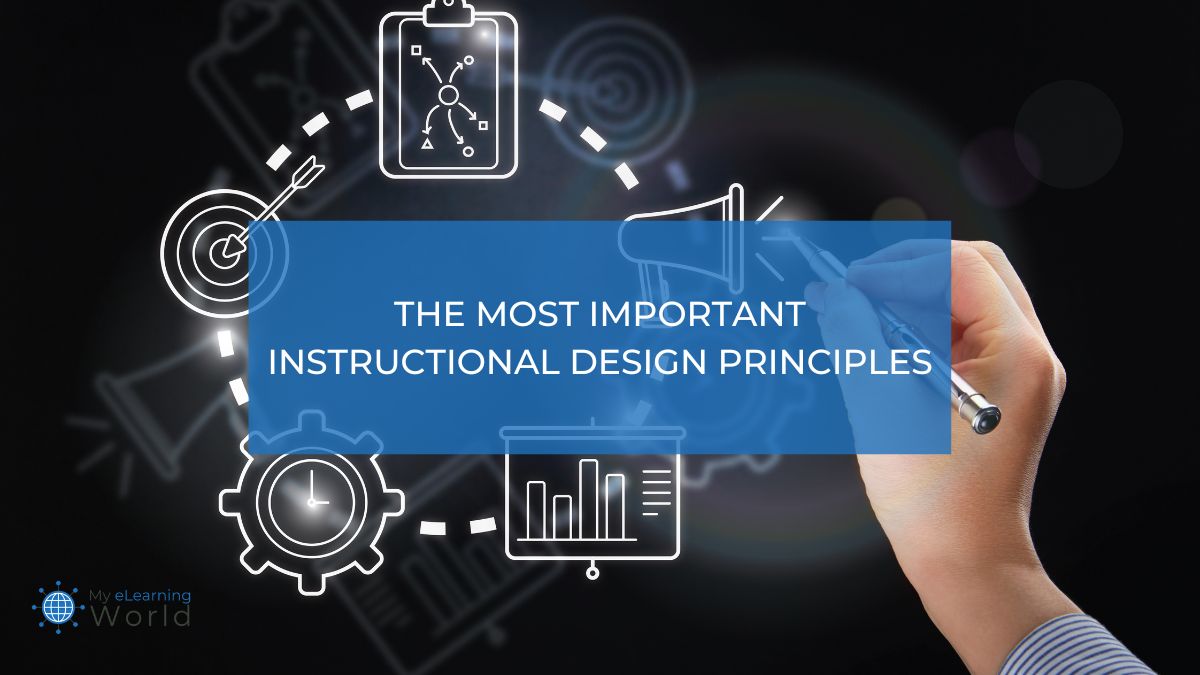Instructional design is a blend of art and science dedicated to creating learning experiences that aren’t just engaging but truly effective. Merging established learning theories with sound principles, instructional designers craft captivating and impactful learning experiences that enhance knowledge retention and skill development.
In the article below, I’m going to cover the most important instructional design principles to follow when creating and implementing new courses and training programs.
Watch Our Report
Check out our latest video discussing some of the most important principles of instructional design!
Key Instructional Design Principles to Know
1. Understanding Learner Needs and Goals
You need to know who you are targeting before jumping right into creating the course content.
When performing a learner analysis, it’s possible to design tailored content that meets the needs of your audience and ensures understandable and useful information.
Establishing recognizable learning goals is another important aspect in the process of ensuring your course achieves learner’s needs and objectives. By setting specific objectives, instructors and their learners are given a map that orients them from anywhere to someplace, it gives direction with purpose.
This clarity makes learning easier for learners by letting them know what they should do while also helping educators align the course content with desired outcomes.
2. Learner-Centered Approach
A learner-centered approach is a philosophy and also pedagogy that focuses on the learner as a very active participant in his or her own learning process. It moves away from the teacher-centered model which centers on an instructor who serves as a major source of information and control to one that emphasizes learner’s needs, interest, or their active participation.
A learner-centered approach to education refers to the process of creating and providing educational episodes that emphasize on the individual needs preferences and attributes. I believe that the best goals are specific, measurable, attainable, memorable, and time-bound (SMART).
Using a learner-centered design approach, instructional designers strive to make the process of learning interesting for all learners while also creating opportunities that enrich the learner’s knowledge about the topic matter. This approach emphasizes the individualization of instruction by promoting active learning and life-long learning skills.
3. Applying The ADDIE Model
The ADDIE (Analysis, Design, Development, Implementation, and Evaluation) approach depicts the most holistic way to instructional design. It’s probably the most popular of all the different instructional design models and one that I use regularly in my work.
Assess the needs of students, then build courses, content and teach lessons before finally evaluating how well a course has performed. This ongoing process ensures a systematic and comprehensive approach.
Analysis:
Purpose: The knowledge of the learners’ needs and characteristics, affecting their learning environment
Activities:
- Learner analysis should be used to determine initial knowledge levels.
- preferred learning styles and possible barriers.
- Establish learning objectives from the analysis
Design:
Purpose: Construct a road map for the course based on the findings of analysis.
Activities:
- Provide an overview of the course outline, which involves modules with lessons and evaluations.
- Create learning activities, educational strategies and multimedia resources.
- Develop a comprehensive course outline including the curriculum and methods of instruction.
Development:
Purpose: Help implement the instructional design plan through developing content and materials.
Activities:
- Create material for the course that includes written materials, multimedia elements and interactive functions as well.
- Organize the resources and materials needed for implementation.
- Make sure that the content fits with previously determined learning objectives.
Implementation:
Purpose: Implement the instructional design plan and deliver this course to target learners.
Activities:
- Initiate the course and supply adequate support to learners.
- Supervise and regulate the learning process, preparing for solving possible problems.
Evaluation:
Purpose: Evaluate the course and set out indicators of its effectiveness.
Activities:
- Ask learners and instructors for feedback.
- Assessment results to be analyzed for the measurement of objectives successes.
- Evaluate the overall performance of the course in realizing its objective.
4. Use of Multimedia Components
I’ve always found that the whole learning process can be enhanced greatly with multimedia elements such as pictures, videos and interactive simulations.
Multimedia elements can meet many demands including different methods and preferences of learning which make the material more memorable as well as interesting.
The inclusion of visuals, videos and interactive aspects helps to keep learners engaged through the complex content. Learners who are actively engaged have a higher likelihood of staying attentive, which results in better retention rates and improved overall comprehension.
I’ve also found that multimedia elements helps to fragment large, convoluted concepts into smaller and manageable pieces. Visual aids such as animations and simulations improve the understanding of complicated ideas by learners, allowing for more in-depth knowledge of what’s being learned.
5. Systematic Planning
A significant element of the instructional design is a systematic planning through which it becomes very possible to organize, structure and also facilitate the materials learning environments. Here are key steps involved in systematic planning within the instructional design process.
- Need analysis
- Define learning objectives
- Task analysis
- Instructional strategies
- Content development
- Evaluation and revision
This is where, following a structured planning process, instructional designers are able to structure and develop purposeful lessons that correspond with the requirements as well as the goals established for educational program.
This systemic manner guarantees a lot of consistency, quality, and also continuous improvement in the instructional design process.
6. Timely Feedback
Timely feedback is a necessary part of the instructional design, and it can greatly influence the efficiency of learning.
On the one hand, it allows the students to measure their performance and evaluate themselves while influencing positive behaviors and also resolving misconceptions in a timely manner. This instant feedback creates an atmosphere of engagement and motivation as the learners get prompt information regarding their own performance, which allows them to correct if necessary.
The provision of timely feedback also facilitates the process of formative assessment, which enables instructional designers to collect critical information about how effective or ineffective certain teaching methods and resources are. This timely data provides the designers with a lot of useful information so that they can make effective decisions for the further enhancement and refinement off the learning experience.
In other words, rapid feedback is a crucial variable in the process of instructional design as it enables agile and very flexible adjustments that lead to improvement outcomes throughout the curriculum.
7. Adaptability and Flexibility
Ensure that all learners, regardless of their abilities, are able to fully engage in learning by designing accessible courses. As the cornerstones of instructional design, adaptability, and flexibility are key foundational components that form a basis for developing lively and also flexible learning constructs.
These core values enable instructional designers to satisfy the learners’ different needs, keep up with contemporary technologies and advance the level of educational curricula.
8. Encouraging Collaborative Learning
To promote teamwork among learners is to have a more meaningful learning process. Use group projects, discussion forums or collaborative assignments that promote sharing experiences and learning from each other.
Collaborative learning not only improves the capacity to understand but also cultivates important teamwork and communication skills.
9. Employ Microlearning
Microlearning is a learner-friendly process that promotes knowledge retention by dividing the main content into small units, which can be incredibly helpful when time resources are limited.
Short modules or lessons that focus on different topics within a specific area allow absorbing information at a more manageable learning rate, boosting overall understanding.
10. Testing and Continuous Review
Over the years, I’ve found that the learning environment is dynamic, and what works today may need not work tomorrow.
You need to constantly monitor the quality of your course on an ongoing basis based upon student feedback, analytics, and score results.
With this data, you can then make informed decisions to consistently evolve your course content for regular improvement.
Other Resources
- How to create an instructional design portfolio
- Instructional designer salary guide
- The best instructional design courses online
- Instructional design resume tips
- Common instructional designer interview questions
- Where to find instructional design jobs
- Instructional design career path
- Instructional design masters programs
- The best instructional design certificate programs
- Top instructional design bootcamps
- How to write an instructional design cover letter
Final Thoughts
I said earlier that instructional design is part art and part science, and I truly believe that. But when we’re talking about the science part of things, there are some key instructional design principles that are truly foundational to creating effective and engaging learning experiences.
These principles, from understanding your audience’s needs to applying the right mix of multimedia elements, are what can transform a good course into a great one.
It’s about leveraging what we know works in education and applying it in innovative ways that resonate with learners today.
So, as you start your next instructional design project, remember to ground your creativity in these proven principles.
Have any questions? Are there any other instructional design principles you feel I left out? Share your thoughts by commenting below.

